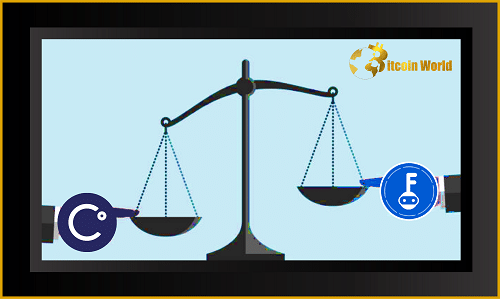The crypto world is no stranger to drama, but the ongoing saga involving Celsius Network has taken another intriguing turn. Remember Celsius, the once-prominent crypto lending protocol? Well, they’re back in the headlines, this time entangled in a legal showdown with KeyFi, a software and investment firm. KeyFi is accusing Celsius of not only breaching their agreement but also operating what they claim was essentially a Ponzi scheme within their lending and borrowing platform. Let’s dive into the details of this unfolding crypto clash.
What Sparked the Celsius and KeyFi Feud?
So, what exactly went down between these two entities? KeyFi initially joined forces with Celsius Network with the aim of reducing risks and providing incentives for those staking their crypto. Think of it as a strategic partnership to make the platform more secure and appealing. However, according to KeyFi’s legal filings, things weren’t as transparent as they seemed. They allege that Celsius Network misrepresented its financial standing, painting a rosier picture than reality by showing inflated balances.
Interestingly, court documents do acknowledge a Memorandum of Understanding (MOU) that granted KeyFi direct shares within Celsius Network. Despite this apparent partnership, KeyFi claims Celsius employed deceptive tactics to conceal their true financial situation. It paints a picture of a company not just struggling, but actively masking its troubles.
The Allegations: High Interest Rates and Hidden Risks
Here’s where things get particularly concerning. KeyFi’s accusations suggest a classic Ponzi-like structure. Imagine offering incredibly high interest rates to attract new depositors. That’s the bait. Then, to keep the cycle going and pay those attractive returns, you need a constant influx of new money. This, KeyFi alleges, is what Celsius was doing, essentially using funds from new depositors to pay off older ones. This is a significant red flag in any financial operation.
Adding another layer to the complexity, KeyFi claims Celsius assured them they were hedging the risks associated with a specific entity known as Oxb1. Hedging, in this context, would mean taking steps to protect against potential losses, specifically impermanent loss, which is a risk in decentralized finance (DeFi) when providing liquidity to pools. However, Oxb1 itself has reportedly stated that no such hedging activities took place. This discrepancy raises serious questions about the management and transparency of Celsius’s operations.
What does this all mean? If KeyFi’s claims are accurate, it suggests that Celsius was operating with significant, unmitigated market exposure. In simpler terms, their assets were vulnerable to market fluctuations, and they allegedly hadn’t taken the necessary precautions to safeguard them. This kind of unhedged exposure can be catastrophic, especially in the volatile world of cryptocurrency.
The Aftermath: Bankruptcy and Bleak Prospects
As it stands, Celsius Network has already filed for bankruptcy. This move essentially halts any ongoing legal battles and initiates a process to manage the company’s debts and assets. Unfortunately, the bankruptcy filing also signals a diminished hope for any significant recovery for those who had funds locked on the platform. The chances of a full revival of the Celsius protocol seem slim, leaving many users facing substantial losses.
Key Takeaways from the Celsius-KeyFi Saga:
- Transparency is paramount in DeFi: This situation highlights the critical need for transparency and accurate reporting within DeFi platforms. Users need to understand the risks involved and have faith in the platform’s operations.
- Questionably high returns can be a red flag: While attractive, excessively high interest rates should always be scrutinized. They can sometimes be indicative of unsustainable or even fraudulent practices.
- Due diligence is crucial: Before depositing funds into any crypto lending protocol, thorough research and understanding of the underlying risks are essential. Don’t just chase high yields; understand the mechanics.
- Legal battles can reveal hidden truths: The Celsius-KeyFi legal dispute is shedding light on potentially problematic practices within Celsius, underscoring the importance of accountability in the crypto space.
- The volatility of crypto requires robust risk management: The allegations of unhedged exposure serve as a stark reminder of the inherent volatility in cryptocurrency markets and the necessity for sound risk management strategies.
What Can We Learn From This DeFi Debacle?
The Celsius and KeyFi situation serves as a cautionary tale for anyone involved in the crypto and DeFi space. It underscores the importance of critical thinking, thorough research, and a healthy dose of skepticism. While the promise of high returns in DeFi is alluring, it’s crucial to understand the potential downsides and the risks involved. Don’t be afraid to ask tough questions and demand transparency from the platforms you engage with.
Ultimately, the unfolding legal proceedings will reveal more about the inner workings of Celsius Network and the validity of KeyFi’s claims. However, the situation already offers valuable lessons about the complexities and potential pitfalls within the world of decentralized finance. Staying informed and exercising caution are paramount in navigating this evolving landscape.
Disclaimer: The information provided is not trading advice, Bitcoinworld.co.in holds no liability for any investments made based on the information provided on this page. We strongly recommend independent research and/or consultation with a qualified professional before making any investment decisions.


